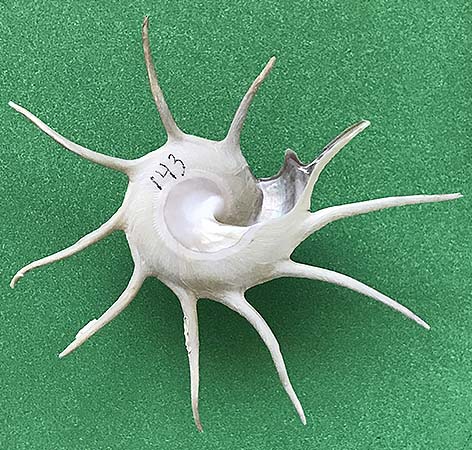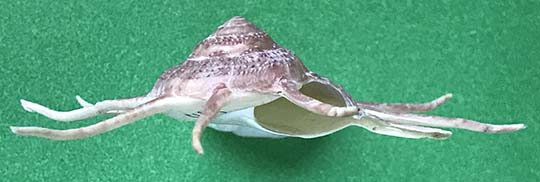GUILDFORDIA: A GASTROPOD WITH A “STARBURST” PATTERN OF RADIATING SPINES
Family Turbinidae, which has a long geologic record ranging from the Late Paleozoic (Permian Period) to modern day, includes the genus Guildfordia, which ranges from the Paleocene epoch (Darragh, 1997) to modern day; [note: this Paleocene species has no spines]. There are at least four living species of Guildfordia, all of which are found in pitch-dark, deep (100 to 200 m and possibly as deep as 500 m), cold marine waters, off Japan, the Philippine Islands, and less reportedly northern Australia. The delicate shells are mostly collected by means of dredge nets.
One of the more “famous” species, Guildfordia yoka Jousseaume, 1888 (a.k.a. the “yoka star turban”) has a low-conic (flattish) shell, which is beautifully ornamented by nine to ten hollow, delicate spines arranged radially. These spines appear to provide stabilization of the shell on muddy bottoms. The interior of the shell is nacreous (shiny, like a rainbow). The largest shells of this species are reportedly up to 100 mm wide (including the spines).
Three views of G. yoka: dorsal, ventral, and right side; maximum diameter (including spines) of this specimen is 70 mm, height 18 mm. Specimen is from the western Pacific Ocean (exact locale unknown).
Cited Reference:
Darragh, T.A. 1997. Gastropoda, Scaphopoda, Cephalopoda, and new Bivalvia of the Paleocene Pebble Point Formation, Victoria, Australia. Proceedings of the Royal Society of Victoria, v. 109, no. 1, pp. 57–108.



No comments:
Post a Comment